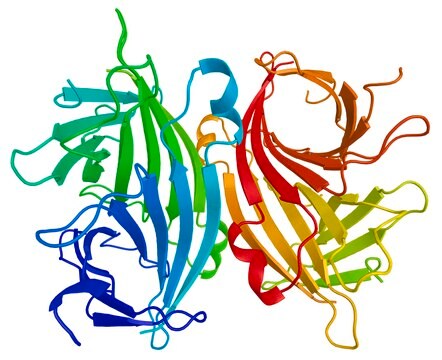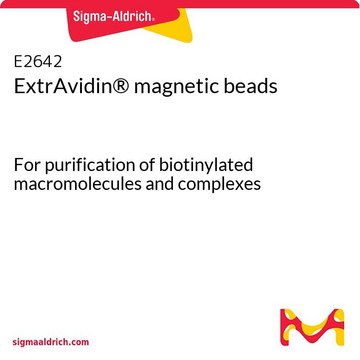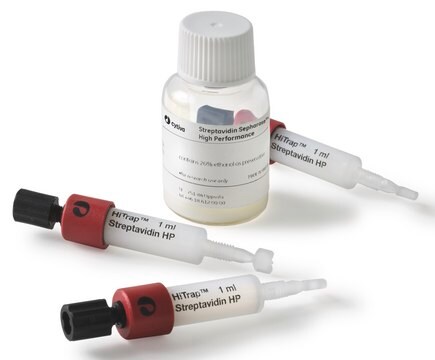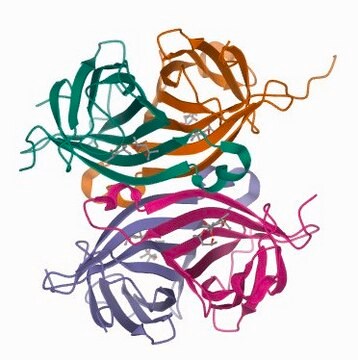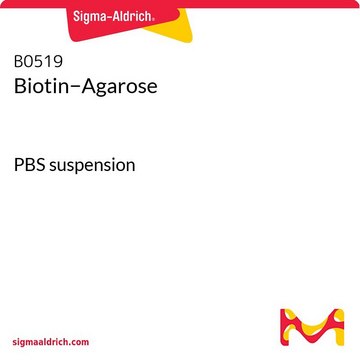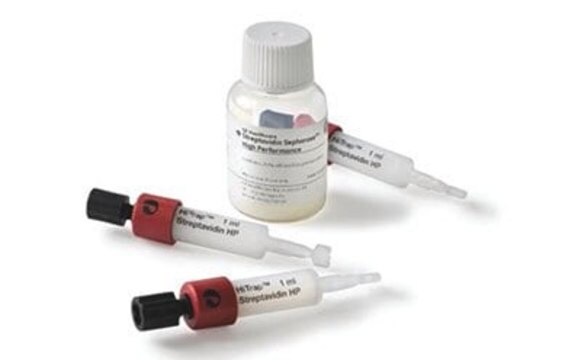E2513
ExtrAvidin®-Agarose, high binding
For purification of biotinylated macromolecules and complexes
Sinônimo(s):
ExtrAvidin® beads, de-glycosylated Avidin
Faça loginpara ver os preços organizacionais e de contrato
About This Item
Código UNSPSC:
41106500
NACRES:
NA.56
Produtos recomendados
Formulário
aqueous suspension
suspension
Características
For purification of biotinylated macromolecules and complexes
concentração
50%
Matriz
4% agarose (beaded)
ativação da matriz
cyanogen bromide
temperatura de armazenamento
2-8°C
Descrição geral
ExtrAvidin® is a unique de-glycosylated Avidin modified form of an affinity purified egg white avidin. The ExtrAvidin is conjugated to cyanogen bromide-activated agarose beads.
ExtrAvidin® is a tetrameric protein containing four biotin binding sites. The Avidin-Biotin high affinity interaction (Kd=10-15M) is considered one of the strongest non-covalent interactions known in nature. The use of Avidin-Biotin complex for affinity purification was described in the first half of 1970 and since then it was successfully utilized in numerous studies and biotechnological applications.1-3 This was achieved due to the ability to chemically coupe the small Biotin molecule with different binders, without disturbing its function or structure, thus allowing unique interaction with a variety of Avidin carriers including: protein or DNA molecules, Avidin protein bound to a solid surface matrix, reporter molecules, probes or carriers,. Among the known Avidin-Biotin interaction based applications are purification, enrichment, detection, amplification and other research medical and industrial processes. In addition, the ExtrAvidin® high specificity binding to Biotin, together with the low background staining, grant it significant advantage compared to the non-modified Avidin or Streptavidin produced by Streptomyces avidinii.
ExtrAvidin® is a tetrameric protein containing four biotin binding sites. The Avidin-Biotin high affinity interaction (Kd=10-15M) is considered one of the strongest non-covalent interactions known in nature. The use of Avidin-Biotin complex for affinity purification was described in the first half of 1970 and since then it was successfully utilized in numerous studies and biotechnological applications.1-3 This was achieved due to the ability to chemically coupe the small Biotin molecule with different binders, without disturbing its function or structure, thus allowing unique interaction with a variety of Avidin carriers including: protein or DNA molecules, Avidin protein bound to a solid surface matrix, reporter molecules, probes or carriers,. Among the known Avidin-Biotin interaction based applications are purification, enrichment, detection, amplification and other research medical and industrial processes. In addition, the ExtrAvidin® high specificity binding to Biotin, together with the low background staining, grant it significant advantage compared to the non-modified Avidin or Streptavidin produced by Streptomyces avidinii.
Aplicação
ExtrAvidin®-Agarose provides high affinity with high specificity binding to Biotin (also known as vitamin B7) including biotinylated proteins and biotin-tagged fusion proteins. The product may be used in various immunological techniques, including Immunoprecipitation and Immunoaffinity purification.
Atenção
DO NOT FREEZE
forma física
ExtrAvidin®-Agarose is provided as suspension at a 1:1 ratio, in 0.01 M phosphate buffered saline, pH 7.4, containing 15 mM sodium azide as a preservative.
Informações legais
ExtrAvidin is a registered trademark of Merck KGaA, Darmstadt, Germany
Exoneração de responsabilidade
This product is for research use only, not for drug, household, or other uses. Please consult the Material Safety Data Sheet for information regarding hazards and safe handling practices.
Código de classe de armazenamento
10 - Combustible liquids
Classe de risco de água (WGK)
WGK 3
Ponto de fulgor (°F)
Not applicable
Ponto de fulgor (°C)
Not applicable
Escolha uma das versões mais recentes:
Certificados de análise (COA)
Lot/Batch Number
Não está vendo a versão correta?
Se precisar de uma versão específica, você pode procurar um certificado específico pelo número do lote ou da remessa.
Já possui este produto?
Encontre a documentação dos produtos que você adquiriu recentemente na biblioteca de documentos.
Os clientes também visualizaram
Samantha Ames et al.
Oncogene, 39(8), 1710-1723 (2019-11-15)
Tumor cells rely on glycolysis to meet their elevated demand for energy. Thereby they produce significant amounts of lactate and protons, which are exported via monocarboxylate transporters (MCTs), supporting the formation of an acidic microenvironment. The present study demonstrates that
Nossa equipe de cientistas tem experiência em todas as áreas de pesquisa, incluindo Life Sciences, ciência de materiais, síntese química, cromatografia, química analítica e muitas outras.
Entre em contato com a assistência técnica

